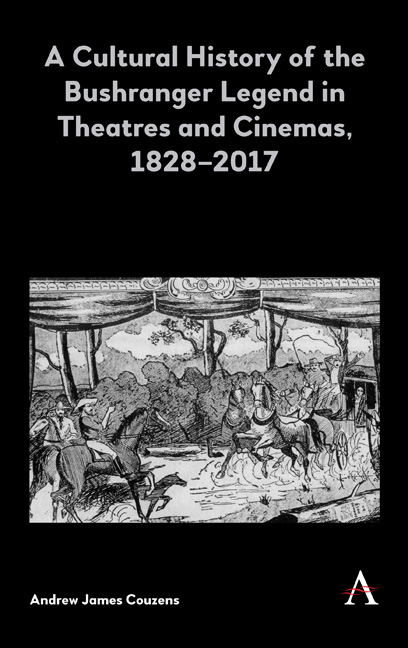Book contents
- Frontmatter
- Contents
- List of Figures
- Acknowledgements
- Introduction: Defining the Bushranger Legend
- Part 1 Establishing the Legend
- Part 2 Developing the Legend
- 5 The Bushranger Genre from Stage to Screen
- 6 The Bushranger Ban
- 7 British and American Interventions in the Bushranger Legend
- 8 Radical Nationalism and the Bushranger Legend
- Part 3 Fragmenting the Legend
- Conclusion
- Bibliography
- Index
5 - The Bushranger Genre from Stage to Screen
from Part 2 - Developing the Legend
Published online by Cambridge University Press: 14 February 2019
- Frontmatter
- Contents
- List of Figures
- Acknowledgements
- Introduction: Defining the Bushranger Legend
- Part 1 Establishing the Legend
- Part 2 Developing the Legend
- 5 The Bushranger Genre from Stage to Screen
- 6 The Bushranger Ban
- 7 British and American Interventions in the Bushranger Legend
- 8 Radical Nationalism and the Bushranger Legend
- Part 3 Fragmenting the Legend
- Conclusion
- Bibliography
- Index
Summary
The advent of cinema offered the bushranger legend a new and distinctive avenue for its representation in Australia, and the subject was extremely popular with filmmakers and audiences for the first decade of film production in Australia. Film and theatre were interrelated for a time, with aesthetic, thematic and industrial borrowings and indistinct boundaries between the two forms. In time the distinctions grew, and cinema carved its own space attracting the popular audiences that had previously patronized stage melodramas and theatrical variety acts. In the years preceding World War I, these borrowings led to an explosion of bushranger- themed narrative cinema, a movement that William Routt has classified as a unique local ‘bushranger genre’. I will interrogate the influences and parallels that this collection of Australian silent era films evokes to bush melodrama and the Australian Wild West shows as well as to international cinema genres including the western. Though the similarities to these other amusements are telling, the deviations are even more interesting. How did the specificities of the cinema lead to distinctive cinematic retellings of bushranger narratives from the stage? How were these films different from the plethora of silent westerns being produced simultaneously in Hollywood? I argue that early Australian bushranger films drew inspiration from, but were not a slavish reproduction of, stage conventions from the colonial period. However, production realities resulted in a subtly distinct mobilization of the bushranger legend that utilized visual language to embed the bushranger characters into their community and environment. Though sharing affinities with the western genre, this bushranger genre therefore establishes its own conventions that mark it as a distinctive, uniquely Australian cinematic formula.
Linking Stage and Screen
As the nineteenth century gave way to the twentieth, new cinema technologies began to disrupt the established entertainment options. Despite this disruption, there was a degree of continuity in the depiction of outlaws between the Australian stage and screen. Cinema shared with the stage an aesthetic interest in sensation through both the reproduction of reality and spectacular staged events. It also borrowed certain staging and blocking conventions from the theatre. These aesthetic continuities are the result of industrial ones in which film and theatre shared venues, audiences, practitioners, actors and even scenarios. This resulted in cinematic representations of outlaws that paralleled their stage counterparts.
- Type
- Chapter
- Information
- Publisher: Anthem PressPrint publication year: 2019



